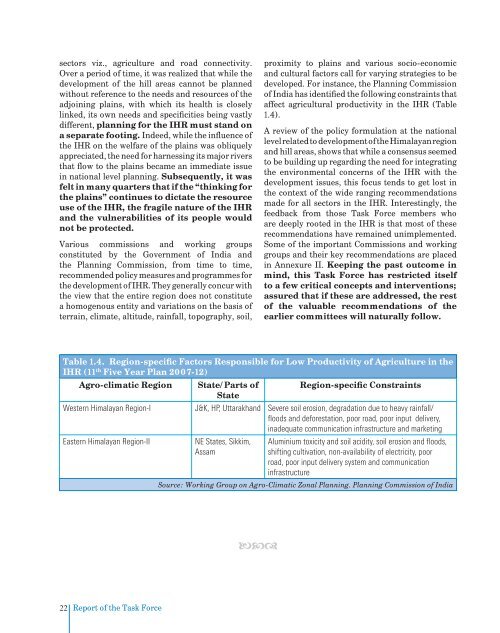Task Force Report - Govind Ballabh Pant Institute of Himalayan ...
Task Force Report - Govind Ballabh Pant Institute of Himalayan ...
Task Force Report - Govind Ballabh Pant Institute of Himalayan ...
Create successful ePaper yourself
Turn your PDF publications into a flip-book with our unique Google optimized e-Paper software.
sectors viz., agriculture and road connectivity.<br />
Over a period <strong>of</strong> time, it was realized that while the<br />
development <strong>of</strong> the hill areas cannot be planned<br />
without reference to the needs and resources <strong>of</strong> the<br />
adjoining plains, with which its health is closely<br />
linked, its own needs and specificities being vastly<br />
different, planning for the IHR must stand on<br />
a separate footing. Indeed, while the influence <strong>of</strong><br />
the IHR on the welfare <strong>of</strong> the plains was obliquely<br />
appreciated, the need for harnessing its major rivers<br />
that flow to the plains became an immediate issue<br />
in national level planning. Subsequently, it was<br />
felt in many quarters that if the “thinking for<br />
the plains” continues to dictate the resource<br />
use <strong>of</strong> the IHR, the fragile nature <strong>of</strong> the IHR<br />
and the vulnerabilities <strong>of</strong> its people would<br />
not be protected.<br />
Various commissions and working groups<br />
constituted by the Government <strong>of</strong> India and<br />
the Planning Commission, from time to time,<br />
recommended policy measures and programmes for<br />
the development <strong>of</strong> IHR. They generally concur with<br />
the view that the entire region does not constitute<br />
a homogenous entity and variations on the basis <strong>of</strong><br />
terrain, climate, altitude, rainfall, topography, soil,<br />
proximity to plains and various socio-economic<br />
and cultural factors call for varying strategies to be<br />
developed. For instance, the Planning Commission<br />
<strong>of</strong> India has identified the following constraints that<br />
affect agricultural productivity in the IHR (Table<br />
1.4).<br />
A review <strong>of</strong> the policy formulation at the national<br />
level related to development <strong>of</strong> the <strong>Himalayan</strong> region<br />
and hill areas, shows that while a consensus seemed<br />
to be building up regarding the need for integrating<br />
the environmental concerns <strong>of</strong> the IHR with the<br />
development issues, this focus tends to get lost in<br />
the context <strong>of</strong> the wide ranging recommendations<br />
made for all sectors in the IHR. Interestingly, the<br />
feedback from those <strong>Task</strong> <strong>Force</strong> members who<br />
are deeply rooted in the IHR is that most <strong>of</strong> these<br />
recommendations have remained unimplemented.<br />
Some <strong>of</strong> the important Commissions and working<br />
groups and their key recommendations are placed<br />
in Annexure II. Keeping the past outcome in<br />
mind, this <strong>Task</strong> <strong>Force</strong> has restricted itself<br />
to a few critical concepts and interventions;<br />
assured that if these are addressed, the rest<br />
<strong>of</strong> the valuable recommendations <strong>of</strong> the<br />
earlier committees will naturally follow.<br />
Table 1.4. Region-specific Factors Responsible for Low Productivity <strong>of</strong> Agriculture in the<br />
IHR (11 th Five Year Plan 2007-12)<br />
Agro-climatic Region State/Parts <strong>of</strong> Region-specific Constraints<br />
State<br />
Western <strong>Himalayan</strong> Region-I J&K, HP, Uttarakhand Severe soil erosion, degradation due to heavy rainfall/<br />
floods and deforestation, poor road, poor input delivery,<br />
inadequate communication infrastructure and marketing<br />
Eastern <strong>Himalayan</strong> Region-II<br />
NE States, Sikkim,<br />
Assam<br />
Aluminium toxicity and soil acidity, soil erosion and floods,<br />
shifting cultivation, non-availability <strong>of</strong> electricity, poor<br />
road, poor input delivery system and communication<br />
infrastructure<br />
Source: Working Group on Agro-Climatic Zonal Planning. Planning Commission <strong>of</strong> India<br />
<br />
22<br />
<strong>Report</strong> <strong>of</strong> the <strong>Task</strong> <strong>Force</strong>

















